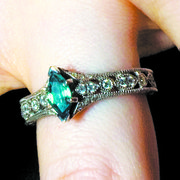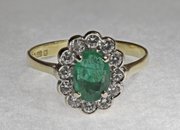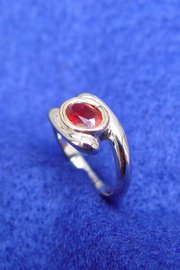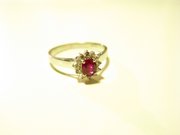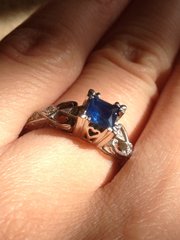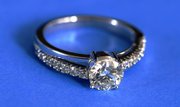Wednesday, November 20, 2013
When shopping for a diamond, you have to worry about the 4 Cs: color, cut, clarity and carat weight.
In many cultures, it's traditional for the man in a courtship to give his betrothed a symbol of their impending marriage.
The first recorded use of a diamond engagement ring was Archduke Maximilian of Austria's proposal to Mary of Burgundy with a ring containing thin, flat pieces of diamond in the shape of an "M."
Since then, and especially after Cecil Rhodes bought out Barney Barnato's mining company and founded De Beer's Consolidated Mines (now just known as De Beers) in 1888, diamond engagement rings have become more and more significant.
They're beautiful and durable with a hardness of 10, the highest score on the Mohs scale. But they're not as glamorous as you think. Diamonds are, in general, prized for their rarity, but they're not actually that rare. The good folks at De Beers have a huge supply, but keep the gemstone "rare" by only selling diamonds in small amounts.
In 1938, De Beers launched an ad campaign to convince men that their significant others needed diamond rings. Then, in 1947, Frances Gerety coined the phrase "A diamond is forever" at N.W. Ayer & Son, De Beers' advertising company back then. A decade of smart marketing changed our perceptions on engagement rings.
Now, I'm not saying you should turn your nose up at diamonds. They're beautiful and brilliant, but don't be so quick to set your mind on the gemstone. As you'll see later, diamonds are finicky. Consider all your possibilities. f you do your research, you can find a stone that fits your budget and your significant other's personality.
Sources: Reader's Digest, neatorama.com
Alexandrite
Hardness: 8.5
Birthstone month: June
Colors: blue, red, green, yellow, pink, purple, gray and multicolored
Durability: With a high hardness rating, they're durable but also rare.
If you were born in June, feel special because your birthstone is one of the rarest gemstones in the world, so don't expect to find a real one easily. It's also difficult to distinguish between real and fake Alexandrite stones. Since it's hard to find a newly mined one of these, most people end up buying period pieces, which can be fairly expensive.
One neat thing about Alexandrite: Many types change colors in different lighting,
Emerald
Hardness: 7.5 to 8
Birthstone month: May
Color: green
Durability: Durable, but any inclusions, or cracks in the stone, may make the gem vulnerable to damage if handled roughly.
Emeralds are notorious for their flaws, which can be hidden by treating the gemstone with oil or a synthetic lubricant. The gemstone is sensitive to pressure and banging. Jewelers developed the emerald cut to relieve the pressure during the stone's cutting. If you have your heart set on an emerald ring, it's important to ask a jeweler to take a look at it.
Garnet
Hardness: 6.5 to 8.5
Birthstone month: January
Colors: red, green, yellow, orange, brown, pink, purple, gray and black
Durability: can withstand everyday use, easy to put into jewelry
Garnets display the widest range of colors, and the varieties are defined by colors. Pyrope, or red garnet, is the most popular color. Demantoids are the most valuable these days because of their emerald-green color. If you're shopping for a garnet, look for varieties such as rhodolite, the pink variation, and andradite, the green variation.
Little known fact: The word Garnet is derived from the Latin word "granum," meaning grain. This refers to the round shape of the gem.
Ruby
Hardness: 9
Birthstone month: July
Color: red
Durability: very durable
Rubies are the most prized gemstones because of their color, durability and numerous other qualities. The colors tend to go from a bright red to a dark reddish brown. The most prized color is a deep blood red with a bluish hue, called a "Burmese Ruby."
Little known fact: Rubies are actually a type of sapphire. They are identical in all properties except for colors, but the red gems have gained so much significance that they became a class of their own. Ruby only comes in red, and sapphires come in a variety of colors except for red, so all rubies are sapphires but not all sapphires are rubies.
Sapphire
Hardness: 9
Birthstone month: September
Colors: white, colorless, blue, green, yellow, orange, brown, pink, purple, gray, black and multicolored
Durability: very durable
Sapphires are tough and durable, but will chip and fracture if you handle them too roughly. The name generally refers to the blue variety. The most valuable type is cornflower blue, which can cost thousands of dollars per carat depending on the particular gem. Any color other than blue is called a "fancy sapphire." Also, the term "white sapphire" actually refers to colorless sapphires.
Little known fact: In ancient times, Persian rulers believed the world rested on a blue sapphire and its reflection colored the skies.
(source: agta.org)
Diamond
Hardness: 10
Birthstone month: April
Colors: colorless, blue, red, yellow, orange, brown, pink, blue gray and black
Durability: Durable but pay attention to the stone's cut and clarity.
When shopping for a diamond, you have to worry about the 4 Cs: color, cut, clarity and carat weight. The color scale ranges from a D-2 to a Y, indicating the intensity of the gem's tint. Colorless diamonds are commonly used in jewelry, but natural diamonds usually have a yellow or brown tint. The cuts range from brilliant to emerald, but some cuts are more dangerous for the stone than others. The clarity of a diamond, determines much of the stone's value and durability. Then, of course, you have the carat spectrum. A carat, labeled as ct, equals .2 grams.
Sources: minerals.net, awesomegems.com
Metals
Gold
Gold is the most sought-after metal in the world. It's durable and flexible, but doesn't oxidize in air and water. White gold is an alloy of the metal, generally made by combining 75 percent gold with 25 percent other metals such as copper. White gold also has rhodium plating to make it more durable, but jewelry has to be re-rhodiumed every 12 to 18 months so the metal doesn't lose its shine.
Platinum
Platinum is a rare metal that resists corrosion at high temperatures, but is the most expensive metal you can buy for a ring.
Palladium
Palladium steel-white and doesn't tarnish. The best part? It's less expensive than platinum and gold, and will make you feel like Iron Man.
Where to Shop:
Juniker Jewelry Co. (4500 N. Interstate 55, suite 116, 601-366-3754, junikerjewelry.com) specializes in diamonds, but if you love antique jewelry, this is the place for you.
Jackson Jewelers (253 Ridge Way, Flowood, 601-992-1700) has beautiful jewelry that combines gemstones with diamonds.
Joel Clarke & Sons Jewelry (1675 Lakeland Dr., 601-983-2600) carries all types of jewelry, including rings.

